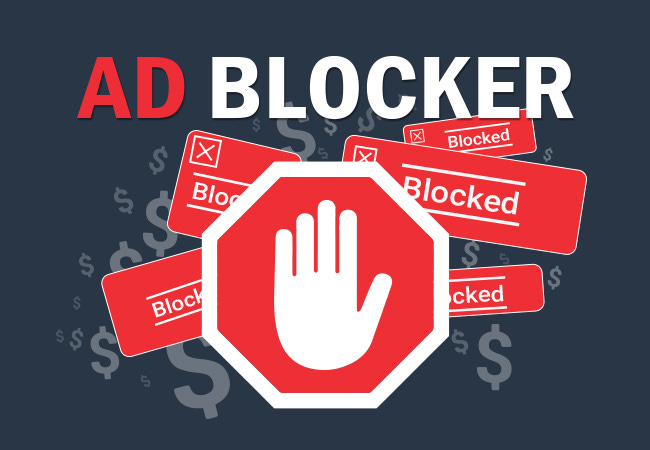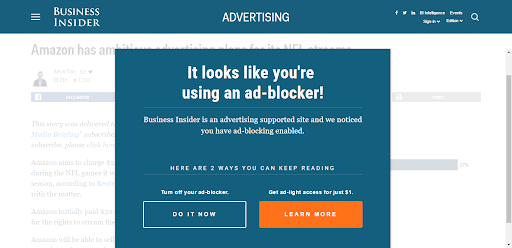Dear reader, If you found value from the regular editions, I would greatly appreciate it if you could share the newsletter with your network. You can click here to tweet about it. If you stumbled across this directly, you can find the previous editions here.
AdBlockers
Ad blockers – sometimes known as content blockers – are simple software programs that prevent ads from being shown on websites. Ad blockers are typically browser add-ons and are available for Chrome, Firefox, Opera, Safari, and Internet Explorer web browsers.

The use of ad blockers has been on the rise in recent years, fueled by web user frustration at the range of noisy, interruptive, and deceptive promotions and offers which appear online. Around 30% of all internet users now use ad blockers, which can be problematic for businesses trying to reach their audiences, and tech platforms looking to demonstrate the value of their ad tools.
Most of the adblockers are free extensions though. But ad blockers are running businesses too. And their business models aren't too far off from the very ones that publishers and advertisers use to make money on the web.
AdBlocker Business Model
The ad-blocking industry can be broken down into a few major categories. Some of them don't make any money at all. But many do, in sometimes surprising ways.
Showing Ads (?!) - Fees and Revenue Split from Whitelisted “Acceptable Ads”
Adblock Plus doesn’t block all ads, but rather operates what it calls an “acceptable ads” program, where ads that meet its criteria for things like placement, size, and distinction, are “whitelisted”—that is, if the company displaying the ads is willing to split the revenue gained by whitelisting with Adblock Plus.
Companies can apply to have their sites whitelisted, but Adblock Plus has also reached out to some to solicit their business. Other ad blockers, such as mobile app Crystal, take a similar whitelisting approach.
Google, Microsoft, and Amazon are paying Adblock Plus huge fees to get their ads unblocked.
Here’s a very interesting HackerNews thread on Google paying AdBlockers.
Like it or not, display ads are still, by and large, the currency of the web, even for Adblock Plus, a company that’s built around reducing the user experience impact of ads online.
Data Aggregation
Ghostery, another popular ad blocker, operates under a different model. As a user, you don't see ads and aren't tracked by pesky data trackers.
The company, however, makes money by collecting anonymized data on what those trackers pick up. It repackages that data and resells it to publishers, websites, and other companies it says can use the information to help improve the speed, privacy, and performance of their sites.
Freemium
Mobile ad-blockers such as Disconnect and 1Blocker operate under a “freemium” model, which allows you to download the service, but then charges for certain options like being able to block more than one irritant at a time.
Donations & Non Profits
AdBlock started with a “Donate via Paypal” button when it launched. It still makes a lot of revenue from recurring donations from a fraction of its 65M users.
Privacy Badger, for example, is a nonprofit blocker operated by the Electronic Frontier Foundation that detects and blocks what it calls “non-consensual tracking," or ads and trackers that follow you around from site to site. The EFF accepts donations (and coding help), but the site itself operates as a nonprofit.
“AdBlock-Bypasser” Monetisation Landscape
Advertisement is essential for Publishers to make money off their online visitors. As millions of users install AdBlockers on their browsers and phones, there are many players building solutions to let publishers “bypass” these adblockers:
Ad Recovery via Acceptable Ads (“AA”)
This strategy entails serving ads that meet the lighter Acceptable Ads spec to opted-in users of participating adblocking extensions, browsers, and content blockers. Large Internet platforms (e.g. Google, Amazon) can and do partner directly with participating adblocking companies to facilitate this because they have full control over their advertising demand and can easily ensure compliance with AA. Publishers reliant on third-party ad tech to monetize their properties would instead work with a dedicated provider like Blockthrough or with third-party vendors like Taboola/Outbrain offering AA support as a feature.
Adblock Circumvention
Circumvention vendors use technological means to evade adblocking and display ads to adblock users, generally without attempting to deliver a lighter ad experience, nor giving the user the ability to opt out.Messaging
Messaging vendors help publishers display dialogs to persuade users to either disable their adblocker or contribute monetarily prior to accessing the content. “Soft” messaging means the dialogs can be dismissed, while “hard” messaging is effectively an “adblock wall” that prevents users from accessing content while adblocking is enabled. Publishers will sometimes build their own in-house messaging solution instead of working with a vendor.
eg: Admiral, Oriel

For more such content, follow me on Twitter.
If you stumbled across this post and would like to receive a weekly article about innovative business models, subscribe now!




How do I get rid of Total adblock? I'm ready to get a new computer rather than popup from that SOB total ad block